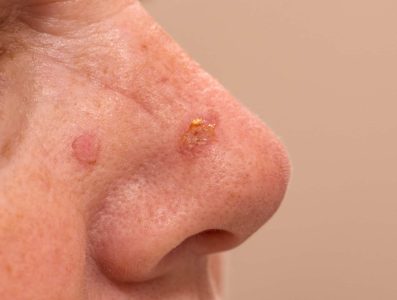Actinic Keratosis

Actinic Keratoses can be diagnosed and treated early to prevent progression to skin cancer
- Very common skin growths which develop as a result of many years of cumulative sun exposure
- Most commonly occurring in fair skin people who have extensive sun damaged skin
- These skin growths occur mostly on sun-exposed areas such as face, scalp, neck, arms and hands
- It is important to diagnose and treat actinic keratoses early to prevent progression to skin cancer
Actinic Keratoses and Sun Damage
Actinic keratoses are small scaly red patches or rough thick skin growths which usually occur in people after age of 40 due to years of cumulative sun exposure.
These skin growths are pre-cancerous, although usually harmless or may cause skin irritation or itch, they may turn into squamous cell cancer, a form of skin cancer, if left untreated.
What causes Actinic Keratoses?
Actinic Keratoses are caused by sun damage from long periods of sun exposure. As they result from cumulative sun exposure over many years, they are more commonly
found in older people.
These skin growths are found predominantly on skin that experiences the most sun exposure such as the face, ears, arms, hands and lower legs.
There are people who are more prone to develop sun damaged skin and actinic keratoses- fair skin, those who burn easily under the sun, people with chronic sun exposure (certain professions, or hobbies, sun-lovers)
Do I have Actinic Keratoses?
It can sometimes be hard to tell if you have actinic keratoses so it is worth checking with our dermatologist if you are worried. Patches of actinic keratoses are usually rough to touch and can be thick and raised from the skin.
These skin growths are often sore or itchy. If an area of the skin which resembles these characteristics starts to bleed, hurt or rapidly change in appearance or size, this may indicate that it is progressing toward skin cancer, and this must be checked.
How do I prevent Actinic Keratoses?
Actinic keratoses are usually little cause for concern. Small patches may disappear by themselves. However, it is important to adopt good sun-protection habits.
As actinic keratoses are caused by exposure to the sun, the key to prevention is avoiding the sun when its rays are most intense, especially around the middle of the day.
Before going outdoors follow the usual sun safety measures of applying sunscreen with a high SPF and protection from both UVA and UVB light and wearing clothes designed to provide sun protection.
It is also important to follow these steps if you already have signs of actinic keratoses in order to reduce the chances of them developing into skin cancer.
Our dermatologist offers skin cancer screening and mole check service to monitor activity of any sun damage, and to detect early signs of actinic keratoses and skin cancer.
How can Actinic Keratoses be treated?
Due to the risk of progression to skin cancer, it is generally advisable to treat actinic keratoses by removing it from the skin. This can be done through a range of techniques including creams, Photodynamic Therapy which uses a photosensitive cream and a light source, Cryotherapy which uses liquid nitrogen to freeze the lesion or Cutterage and Electrocautery which uses a small blade and electrical energy to remove the sun-damaged skin cells.
DISCLAIMER:
The information written and published on this website is not intended to substitute the recommendations of a trained professional and does not replace a professional consultation.
It is advisable to undergo a formal consultation to help establish a relationship between the doctor and yourself, accurately determine your concerns/problems, and get the appropriate treatments for them.
It is also imperative to note that the contents of the website with respect to treatments, results and pricing can vary from individual to individual, and can only be accurately determined by the doctor upon diagnosis.
Do note that all medical treatments will only be administered upon proper consultation, with the requirement that patients be above 21 years of age to provide legal consent.
Skin Cancer
Meet your Dermatologist

Dr Tay Liang Kiat
Dermatologist
Dr Tay Liang Kiat is a fully accredited Dermatologist who specialises in skin cancers, Mohs micrographic surgery, dermatologic and nail surgery, aesthetic dermatology and laser procedures. With more than 20 years of clinical experience, he also manages other aspects of general ambulatory and inpatient dermatology, including eczema, psoriasis, acne, urticaria, hair loss, children skin issues and other complex medical dermatology. In addition, he has expertise in the use of the latest immunotherapy (biologics) treatment for severe eczema, psoriasis and urticaria.



